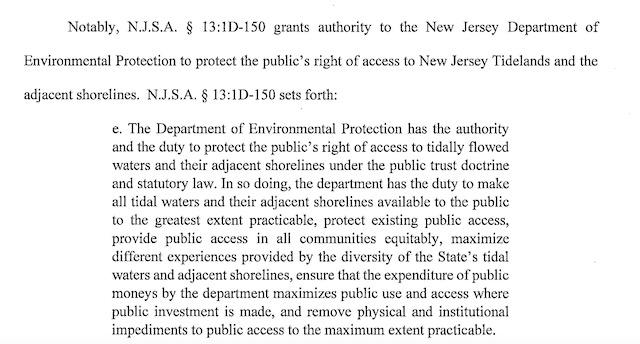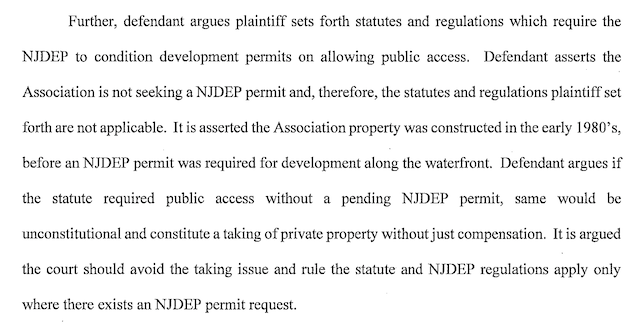Where Was The Murphy DEP? What Happened To DEP’s “Duty to Protect”?
Why No Public Enforcement Of Public Trust Doctrine?
Vindication of The Public’s “Inalienable and Vested” Access Rights Relies On Private Enforcement
[Updates – Clarifications – Below]
NJ Spotlight reports that a Bergen County Superior Court decision upheld the Public Trust doctrine in an important decision involving public access to the Hudson River waterfront, see:
The case was praised as a victory on a “critical issue” and the first to test a recent piece of legislation:
Tim Dillingham, executive director of the New Jersey-based American Littoral Society, said the ruling is the first he is aware of to use a 2019 state law on public access to support its findings.
“It is really critical that property owners understand that their right of ownership does not include the right to exclude the public from accessing the waterfront via formerly submerged lands,” Dillingham said
In emphasis on the limitations of the rights of private property owners, Dillingham revealingly has framed the issue exactly backwards. And he does so in a way that masks a critical issue.
The Public Trust doctrine is an affirmative public right that must be enforced by public agencies, i.e. the DEP.
In this case, the realization of the Public Trust Doctrine is essentially limited to the kindness of strangers: i.e. it is only effectuated by enforcement by a private lawsuit by the Hudson River Waterfront Conservancy (a group who was acting as a lot more than what they describe their function to the Court as the “eyes and ears of DEP” (cite omitted). In this case, they were acting as DEP’s private enforcement arm.).
I’ve written to criticize that law Mr. Dillingham again praises as effectively narrowing the Public Trust doctrine, see:
Just 2 days after DEP’s announcement of that $1 million grant [to ALS], Dillingham was quoted in Gov. Murphy’s press release praising the Gov. for signing the public access law:
“We thank Governor Murphy for signing this important legislation. It will strengthen the protection of the public’s rights to get to and enjoy NJ’s beaches and waterfronts,” said Tim Dillingham, Executive Director of the American Littoral Society. “It will provide new tools to deal with long standing public access problems. We look forward to working with the administration to getting this law implemented and getting New Jerseyans everywhere to the waters that they have a right to enjoy.”
So – especially after that big wet kiss “thank you” – where was the Murphy DEP in “getting the law implemented” and enforcing this “important legislation”?
I want to highlight important limitations in the Doctrine, as illustrated by this case.
Those key limitations are alluded to in a vague single sentence at the end of the NJ Spotlight article:
The Department of Environmental Protection, which enforces the public trust doctrine, declined to comment on the ruling.
DEP did a lot more than decline to comment.
DEP failed to enforce the public trust doctrine and they failed to intervene in this case to seek its enforcement by a private party.
The Court’s decision makes that clear. The Court noted that DEP was granted authority to enforce the Public Trust doctrine by the law that Dillingham praises:
So, if DEP has that authority, why didn’t they enforce it?
What happened to DEP’s “duty to protect the public’s right of access”?
How could the public’s right of access to the waterfront – which the court found was “inalienable and vested “(decision @p.22) – not be enforced by the DEP?
The defendant’s brief explains why – an issue that is completely ignored by the Court’s decision, the Spotlight article and Mr. Dillingham – and that explanation exposes a huge weakness in the law and DEP enforcement powers and policy:
Let’s repeat that:
Defendant asserts that the Association is not seeking a DEP permit and, therefore, the statutes and regulations plaintiff set forth are not applicable.
That fact, i.e. the there was no DEP permit involved, exposes the fact that the Public Trust Doctrine is limited by the fact that DEP can not broadly assert it unless a permit review is pending.
Why should public access to a regional waterfront corridor depend on a private group to file a lawsuit (and one that DEP did not seek to join as a Plaintiff or even submit an Amicus brief in support of)?
The Hudson River Walkway is a State planned DEP riverfront corridor project that is incorporated in DEP’s Coastal Zone Management Rules:
The concept for the Hudson River Waterfront Walkway first appeared in “The Lower Hudson”, a study completed in 1966 by the Regional Plan Association. Twelve years after the publication of “The Lower Hudson”, Governor Brendan Byrne established the Hudson River Waterfront Study, Planning, and Development Commission. Their final report included a recommendation for a continuous public walkway extending along the Hudson River
In 1988, the Coastal Zone Management rules established specific criteria for development along the Hudson River Waterfront Area including the creation of the Hudson River Waterfront Walkway. When complete, this Walkway will be an urban waterfront corridor connecting the George Washington Bridge in Fort Lee with the Bayonne Bridge in Bayonne. As the crow flies it will extend about 18.4 miles, but the total length will exceed 40 miles. Nearly complete, the Walkway offers residents and visitors spectacular views of the Statue of Liberty, the New York City skyline, Ellis Island, and the Hudson River.
Yet DEP failed to and apparently legally could not enforce public access because no individual permit was involved.
So, that means that the realization of public access rights is narrowly limited to single site specific lawsuits filed by private individuals or organizations, as opposed to broad planning and enforcement by the DEP in the public interest.
That is a LOSS for the Public Trust doctrine, not a victory.
[End Note: We wrote just yesterday to criticize DEP for “abandoning regulatory enforcement” and Mr. Dillingham and ALS, but unfortunately we left out his cheerleader role in the public access issue, which is exposed today.
It is amazing that NJ Spotlight could let Dillingham and DEP off the hook in today’s story, isn’t it? After they previously quoted Dillingham praising the law and looking forward to working with DEP to implement it and then DEP completely bails, refuses to enforce that law, and then has “no comment” on it?.
So, let me repeat that criticism today:
- American Littoral Society has been virtually silenced on issues they have taken a leadership role on: they’ve done nothing to challenge the Murphy DEP’s failure to enforce the Clean Water Act to prevent the ecological collapse of and restore Barnegat Bay (this is doubly shameful, because Tim Dillingham, head of ALS, hails from the shores of Chesapeake Bay, where he knows that the US EPA is using a TMDL cleanup plan to restore the Bay); DEP’s failure to enact long delayed numeric water quality standards for nutrients; DEP’s proposal of a gaping “variance” loophole in clean water act regulations; failure to strengthen CAFRA and limit coastal sprawl development; and failure to reform NJ’s Blue Acres and Coastal Management programs to consider a policy of “strategic retreat” from climate driven coastal flooding, sea level rise and storm surge. ALS is AWOL and crickets on all that and more, all issues they’ve led on in the past. ALS has received millions from prior DEP grants.
[Update – Clarification – I got some pushback on this from people I respect, so feel the need to clarif
I’m no lawyer, but the following signs are all in the same direction (please read the case and note distinction between the scope of the Public Trust Doctrine, i.e. what are the bundle of public rights, versus WHO can enforce those rights.
I am NOT arguing that a private individual can not enforce the Public Trust Doctrine, I am just describing this case and noting that this is a real problem, it was raised by the defendants, it was not resolved by this decision, it is likely to be appealed, and the DEP’s failure to enforce is troubling. Consider the following facts:
1) I excerpted the DEP permit claim from the Condo Assc.’s legal brief;
2) The Court specifically mentioned that issue but did not rule on it
3) the DEP, for years, never intervened to enforce their own CZMA regulations or the Public Trust Doctrine as common law, instead allowing a single parcel to block completion of the walkway.
4) the DEP did not join the lawsuit as a plaintiff.
5) the DEP did not file an Amicus brief to defend the Doctrine, their regulations, the 2019 law Gov. Murphy signed, or the private common law rights of the plaintiffs.
6) the DEP had no comment to the media on the decision.
All that tells me that there are real problems regarding enforcement and that DEP may be limited to enforcing the doctrine only via the permit process.
On top of that, the 2019 law the Court relied on, whether or not a private plaintiff or DEP brings the lawsuit, explicitly narrowed the scope of DEP’s permit regulations in terms of the kinds of public access that DEP could enforce in the DEP permit program and the kinds of mitigation DEP could extract as permit conditions. That’s the law Tim Dillingham negotiated and praised.
And that’s a big problem too.
[Update #2 – 2/7/23 – I need to correct and clarify the criticism of DEP. I asked a local expert about this and he just advised me of the following, which explains why there was no DEP permit or enforcement intervention at Admiral’s Walk:
The Hudson River Waterfront Conservancy has been working closely with the NJDEP on this case. The NJDEP has been able to get another developer to cover the cost of rebuilding the walkway at the Admiral’s Walk site but the condo assoc. decided to challenge this prior agreement. Admiral’s Walk was built prior the state’s Coastal Zone Management Regs going into effect which explains why this gap site has remained for all this time.


